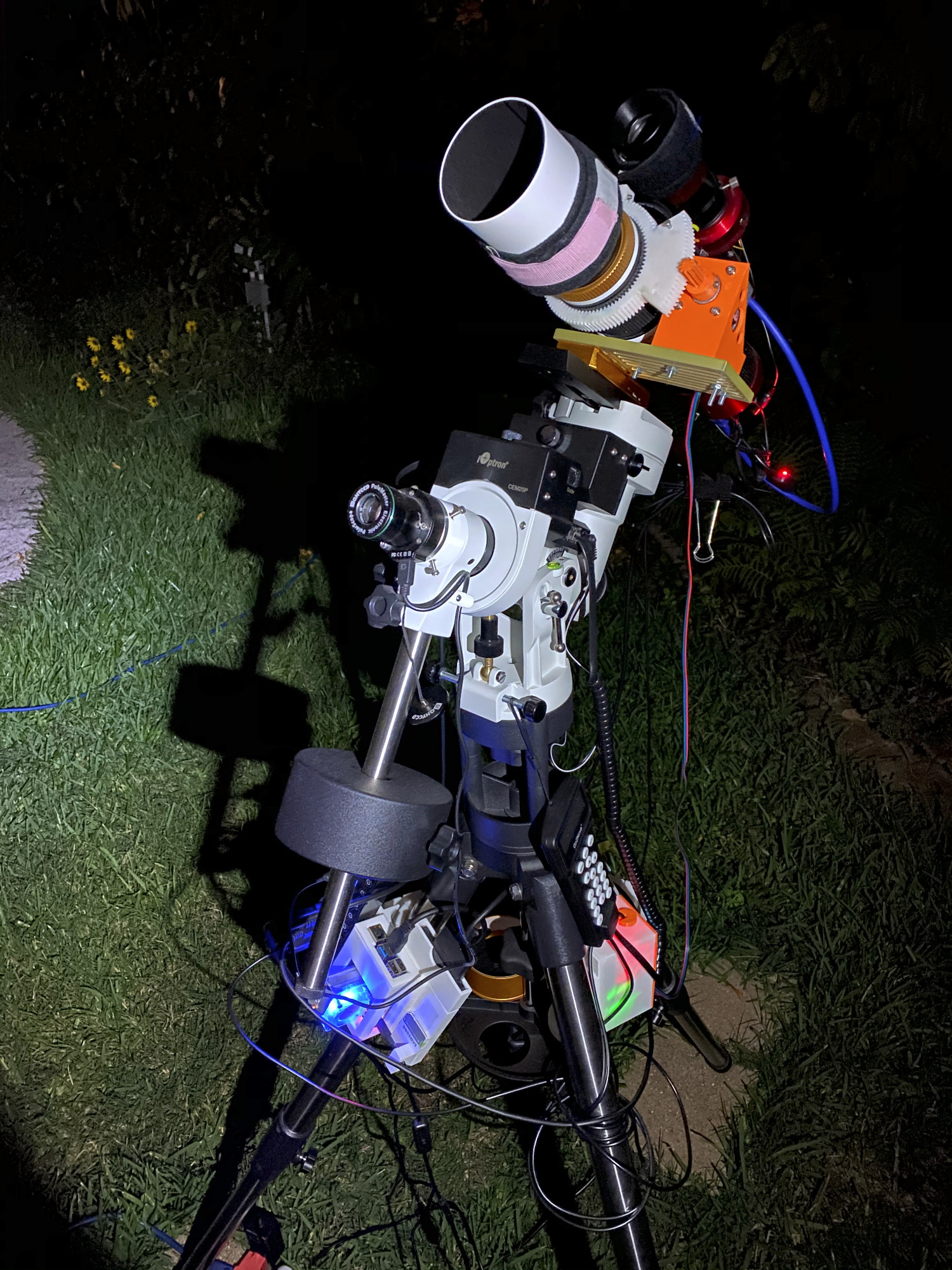INDI Library v2.0.7 is Released (01 Apr 2024)
Bi-monthly release with minor bug fixes and improvements
How can I enter a backlash value for my focuser?
- Jose Corazon
-

- Offline
- Supernova Explorer
-

- Posts: 1119
- Thank you received: 182
Replied by Jose Corazon on topic How can I enter a backlash value for my focuser?
I presume that comment is directed at my post, because that is the only one that has posted a V-curve.
This is entirely self-built autofocuser on a WO WhiteCat (helical focuser). It is a geared solution driven by a NEMA17 stepper motor and MyFocuserPro using the MoonLite protocol.
The design of the focuser (3D-printed) allowed me to virtually eliminate backlash, so the focuser hits optimal position literally every time.
Please Log in or Create an account to join the conversation.
- Daniel DeSclafani
-

- Offline
- Premium Member
-

- Posts: 118
- Thank you received: 16
Replied by Daniel DeSclafani on topic How can I enter a backlash value for my focuser?
Please Log in or Create an account to join the conversation.
- Jose Corazon
-

- Offline
- Supernova Explorer
-

- Posts: 1119
- Thank you received: 182
Replied by Jose Corazon on topic How can I enter a backlash value for my focuser?
Please Log in or Create an account to join the conversation.
- Jose Corazon
-

- Offline
- Supernova Explorer
-

- Posts: 1119
- Thank you received: 182
Replied by Jose Corazon on topic How can I enter a backlash value for my focuser?
It took me a little tinkering to get used to, but now it is working very well for me. The problem is that the stepper motor in DEC is underpowered or poorly matched to the board, which results in it missing steps, if there is too much resistance. It is essential to balance the mount perfectly and also not to tighten the tension screws too much. Just enough so that all discernible wiggle in DEC has been eliminated. That way, I can get good performance out of it.
I wish iOptron were offering the option to modify the firmware on the DEC board to allow me to fine tune the stepper to the board. If I could do that, this mount would be perfect in all respects.
I got it primarily because it is light enough so I can carry the setup full assembled from the living room into the backyard. 2 min setup and tear-down time. That was my primary criterion for going with the CEM25P instead of an HEQ5.
Please Log in or Create an account to join the conversation.
- Rick Wayne
-
 Topic Author
Topic Author
- Offline
- Elite Member
-

- Posts: 222
- Thank you received: 20
Replied by Rick Wayne on topic How can I enter a backlash value for my focuser?
Still, I appreciate the attempt to help!
If the skies ever clear again I'm going to try with a smaller initial step value -- the smallest that will cause a visible change in the focus -- and a bigger multiplier, so that the initial move definitely takes out the backlash.
I also may change the driver a bit, my motor combined with microstepping makes 10 or even 100 steps completely invisible with Kevin's driver out of the box, so I put in a big multiplier to actually get the shaft to move.
Please Log in or Create an account to join the conversation.
- Jose Corazon
-

- Offline
- Supernova Explorer
-

- Posts: 1119
- Thank you received: 182
Replied by Jose Corazon on topic How can I enter a backlash value for my focuser?
What you are describing is the result of excessive backlash. The linear algorithm assumes there is none and that is what the step calculations are based on. The shift in the curve after the V-curve has been established and then the focuser moved out again is a direct measure of the backlash in your system.
I would think that it would not be too difficult for Hy to implement a backlash compensation in his algorithm, once he is done with his current course work.
But from what you are describing, your system needs some serious tightening up.
Also, you may want to play around a little with the tolerance value. You need at least 5%, otherwise the focuser will fail too often. It never fails in my setup at 5% tolerance.
Please Log in or Create an account to join the conversation.
- Rick Wayne
-
 Topic Author
Topic Author
- Offline
- Elite Member
-

- Posts: 222
- Thank you received: 20
Replied by Rick Wayne on topic How can I enter a backlash value for my focuser?
Wait, what? Did you not previously write:
One of these things is not like the other
I mean, "excessive" I might certainly buy, since a step size of 100 makes a visible focuser tube displacement but can be nearly eaten by backlash.
So, as nearly as I can tell, the backlash is actually in the motor; there's really nothing I can do about that without replacing it. Although I recognize that geartrain backlash in a commercial motor seems unlikely compared to my laughably crude setup displaying, shall we say, idiosyncrasies...still, when I reverse direction the thing gronks for a couple seconds and only then does the shaft start to turn. A subsequent move in the same axis makes the gronking and turning simultaneous.
When I ordered the timing pulley they sent me one with a bore about triple the size of what I'd asked for; coming up with a crude bushing for that left me with a setup that certainly might be susceptible to backlash, although as I noted that doesn't appear to be happening. I've ordered another, we'll see what arrives in a week or two on the slow boat from China.
Please Log in or Create an account to join the conversation.
- Jose Corazon
-

- Offline
- Supernova Explorer
-

- Posts: 1119
- Thank you received: 182
Replied by Jose Corazon on topic How can I enter a backlash value for my focuser?
Let me rephrase: The linear focuser inherently compensates for backlash, as it moves so far out, then back in, that it eats up all the backlash in the process.
HOWEVER: While establishing the V-curve, the Linear algorithm determines the calculated minimum on the assumption that there is no backlash. It moves out accordingly and then performs a calculated move towards that minimum. Any backlash will displace the second inward curve by that amount. In addition, if you excessive backlash, it is theoretically possible that the outward movement does not extend beyond the calculated minimum, which will send your focusing attempt off into Nirwana.
That's what I wanted to convey in fewer words and where I obviously failed miserably.
When you look at the curve I posted, it is obvious that there is essentially zero backlash, as the secondary inward curve nearly perfectly overlaps the primary V-curve.
If you have a geared stepper and a gearbox with a lot of play, that will be difficult to fix. I have opted against using a stepper with a gearbox and I am using direct drive microstepping instead. I was worried about steps being missed, but it seems to be working surprisingly well. No major problem with missed steps.
Jo
Please Log in or Create an account to join the conversation.
- Hy Murveit
-

- Away
- Administrator
-

- Posts: 1221
- Thank you received: 565
Replied by Hy Murveit on topic How can I enter a backlash value for my focuser?
To rephrase, there is no explicit backlash compensation in Linear, but rather the algorithm tries to set itself up in a situation without backlash.
It does this by first moving far "out", then moving back "in" by quite a bit, in hopes that the inward motion eats up all the backlash.
It then tries to sample a v-curve, moving "in" by step size, sampling the HFR, moving in again ... eventually find where the bottom of that curve is
(by moving past the minimum and noticing the HFR has started to increase). It really doesn't care what the absolution position is, just the value of
the HFR at the bottom of the V. It then performs its 2nd pass, whose goal is to find the minimum again and stop there (at whatever
absolution position, doesn't matter). It does that 2nd pass by again moving back out quite a bit, and again reversing to inward, moving quite a bit to
again hopefully eat up all the backlash. Hopefully, the position it finds itself in at that point is outside the minimum HFR position.
It then performs its 2nd inward sweep, iterating the following: moving in my 1/2 step size, measuring an HFR, and deciding if its done.
It's done if the measured HFR is close enough to the minimum HFR from the 1st pass (and its no longer decreasing).
It may decide that something went wrong, and instead of going off to nirvana, repeating the backward/forward motion.
It always terminates after 30 steps.
It's not perfect, but can often overcome backlash.
Please Log in or Create an account to join the conversation.
- Rick Wayne
-
 Topic Author
Topic Author
- Offline
- Elite Member
-

- Posts: 222
- Thank you received: 20
Replied by Rick Wayne on topic How can I enter a backlash value for my focuser?
OK, now I think I understand what's going on with the algorithm; it's actually pretty much like what I thought it would be. And given that my backlash is something like 90 steps, and the linear algorithm moves out, then in, several times that at least every time it does a run, you'd think it would Just Work. Maybe there's another source of ugly of which I'm unaware.
I should definitely increase the tolerance, thanks for that suggestion. It's painful to watch it achieve really good focus, then move away from that to establish the other side of the curve, and then never manage to find that point again, poor thing! I think what I might need to do is bring a micrometer and measure where the focusing tube actually is at these points on the curve. I tried to keep track of it on the fly by doing all the arithmetic in my head but that worked about as well as you'd expect for a tired old fart in the dark and cold.
If only I could work on this any time I wanted! I've even thought about poking a pinhole in a piece of cardboard, hanging that on the fence with a light behind it, and pointing the scope out the window at it. Who knows, it could work. Of course now it's not just cloudy but RAINING, so it would have to be something waterproof...
Re nirvana: I can't remember which politician he was referring to, eons ago, but I clearly recall the comedian Mark Russell talking about how in the middle of their speech, this pol "segued off into the Realm of The Moonbeam". I think <em>nirvana</em> would be perfect automatic focus, this is something more like TROTMB.
Please Log in or Create an account to join the conversation.
- Jose Corazon
-

- Offline
- Supernova Explorer
-

- Posts: 1119
- Thank you received: 182
Replied by Jose Corazon on topic How can I enter a backlash value for my focuser?
Please Log in or Create an account to join the conversation.
- Rick Wayne
-
 Topic Author
Topic Author
- Offline
- Elite Member
-

- Posts: 222
- Thank you received: 20
Replied by Rick Wayne on topic How can I enter a backlash value for my focuser?
Well, imagine my surprise when I put in a value for that and the pulley started whirling around at speeds never before seen!
If there's backlash, it's less than a step, which means less than 0.03mm focus-tube linear movement by my measurements.
Think I probably got it now. Sigh. Thanks again for all the help. I'll let you know the next time I can see stars how it actually goes.
Edited to add: I don't have stars, but I have cardboard, a headlamp, and a clear drybag (it's raining). So I made a pinhole in the cardboard and taped the light behind it, set it out as far out in the backyard as I could go, and pointed the scope at it. Given the limitations of my "star", I think I got excellent results, every focusing algorithm converged and linear seemed to do so pretty directly and with no weirdness. There is perhaps a little more backlash than I thought, but it's at most on the order of 15-20 steps, not 100. I took out the backlash and made a careful measurement of focus tube movement over 2000 steps with a digital micrometer. Came out to 4.8 microns per step. With a CFZ calculated at 46.5 microns, that should be adequiate to achieve critical focus repeatedly. Can't wait for stars now!
Please Log in or Create an account to join the conversation.

